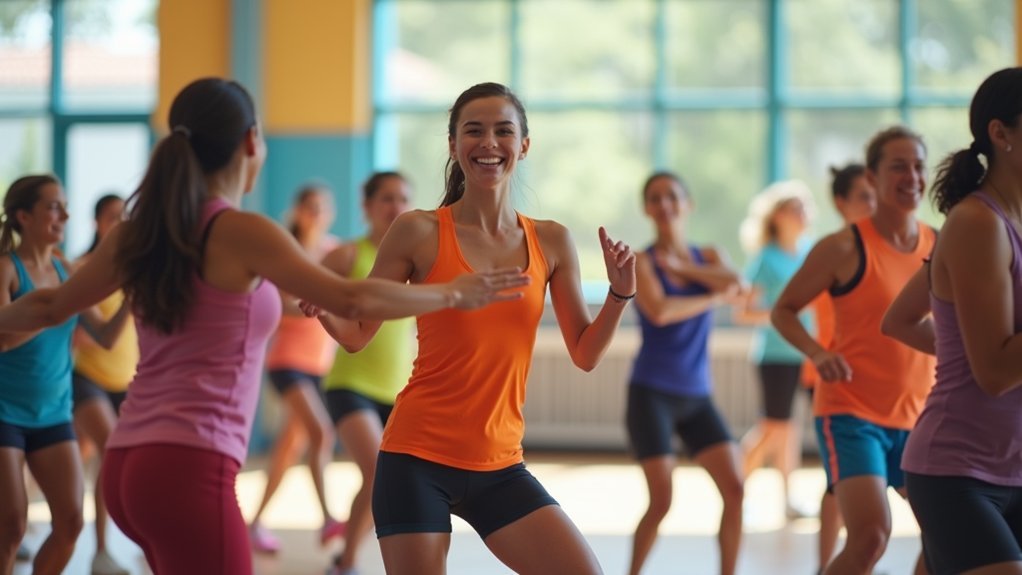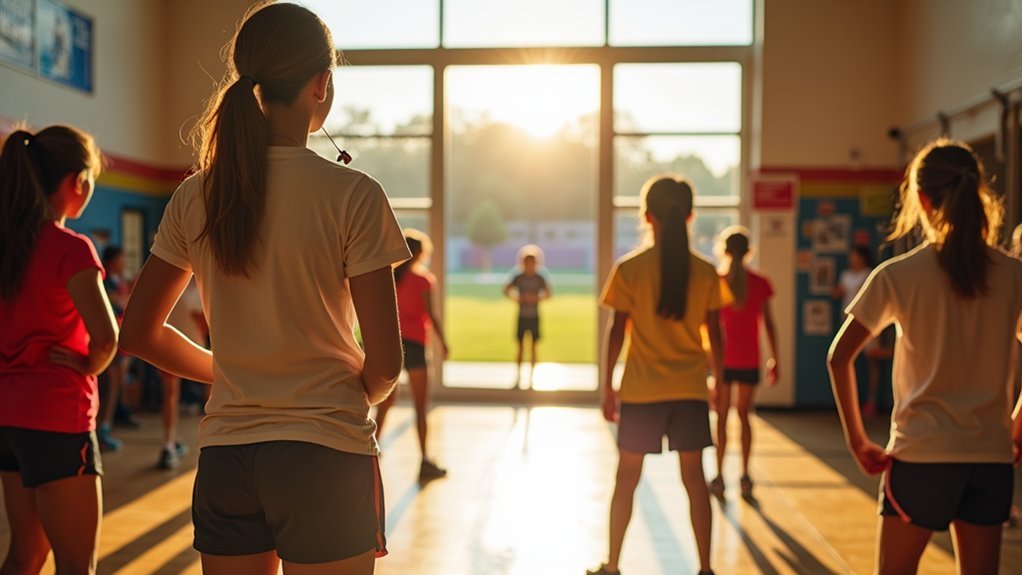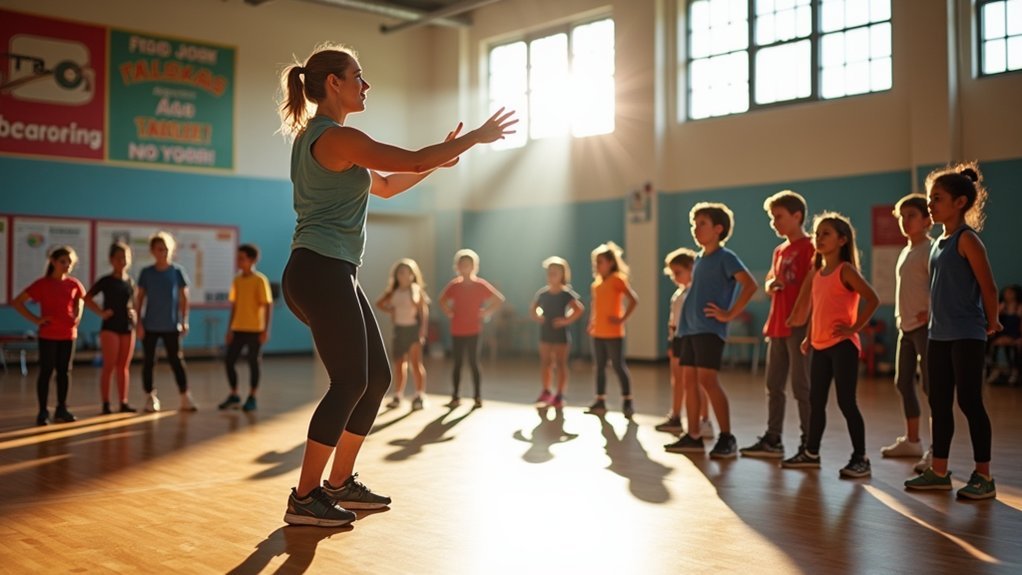Physical education is a viable career path for those passionate about promoting health and fitness. It includes teaching students about physical activity and healthy lifestyles. In spite of modest job growth and challenges such as engaging diverse learners and variable job availability, physical education offers opportunities to positively impact student health and well-being. The profession sees diverse career possibilities, from teaching and coaching to sports management. Exploring further will reveal insights into career prospects and opportunities.
Key Takeaways
- Physical education offers diverse career opportunities in teaching, coaching, and sports management.
- The job market for physical education teachers is growing modestly, with a focus on health awareness driving demand.
- Salaries for physical education teachers vary widely, with potential for higher earnings in certain states.
- Continuous professional development and specialized certifications enhance job prospects and career advancement.
- Challenges include engaging reluctant students and limited availability of permanent roles, but benefits include flexibility and positive societal impact.
Is Physical Education a Good Career Path? Let's Explore

A career in physical education involves teaching students about physical fitness, health, and sports, often in K-12 educational settings. Physical education teachers typically need a Bachelor's degree, a teaching license, and skills in motivation and cultural sensitivity to effectively engage diverse student populations. Physical education is closely related to the impact of extracurricular activities on personal growth, offering students opportunities for personal development. While the overall employability rating for physical education teachers is rated D by CareerExplorer, weak employment opportunities are expected for the foreseeable future. In spite of facing challenges such as budget constraints and regional job market variations, these professionals may improve their career prospects by pursuing advanced degrees and taking on additional roles like coaching sports teams. Notably, states like California, Texas, and New York account for a significant portion of physical education teaching jobs, which can influence job seekers to consider relocation to these areas for better opportunities. With a majority of physical education teachers working in education companies, this career path is more aligned with the public sector rather than private enterprises.
What does a career in Physical Education involve?
A career in physical education involves planning and implementing lessons that teach students about sports, fitness, and health-related topics. Professionals in this field must possess a bachelor's degree in physical education or a related field, along with state teaching certifications and strong communication skills. Effective communication is essential in leadership roles, including physical education, as it fosters better team dynamics and enhances understanding among students. They are responsible for maintaining student safety, evaluating progress, and adapting activities for those with special needs, all while managing classrooms and organizing activities efficiently. Continuous education and professional development are important to keep skills updated and enhance teaching effectiveness.
Common responsibilities in Physical Education
When considering a career in physical education, comprehension of the common responsibilities is critical for aspiring educators. Educators engage in curriculum innovation to align lesson plans with standards, promoting student engagement through technology. They guarantee safe environments and manage resources effectively. Evaluating student development is essential, alongside classroom management and safety. Collaboration and professional growth are likewise fundamental components of their responsibilities. Additionally, yoga teachers, for example, focus on spiritual, mental, and physical elements of fitness, assisting students in learning stretching poses and breathing exercises. Developing effective decision making skills is crucial for educators to optimize their time and prioritize impactful activities within their professional responsibilities.
Required skills for success
Success in a physical education career hinges on a diverse set of skills that cater to both subject knowledge and interpersonal abilities. Core skills include comprehension of exercise physiology, kinesiology, sports science, and motor skills development. A solid foundation in exercise physiology and anatomy is important for understanding body movement and the impact of activities on various muscle groups. Effective team collaboration and promoting student engagement are crucial. Physical education teachers often guide students in physical activities and adapt lesson plans based on circumstances, requiring patience and adaptability for varying student needs. Strong communication, creativity, and leadership qualities improve teaching. Organizational skills, adaptability, and enthusiasm for fitness further contribute to success in this field. Engaging communication is key, as it encourages participation and helps students enjoy physical activity. Developing critical thinking skills is essential for creating effective lesson plans and addressing diverse learning challenges.
Is There Demand for Physical Education Professionals?
The demand for physical education professionals is shaped by industry trends and a positive job market outlook. Although the job market for physical education teachers is expected to grow modestly at 3.1% by 2032, specialized roles like adaptive physical education are emerging and may present new opportunities. In spite of budget constraints that occasionally affect class offerings, the broader growth in health and physical education roles indicates a steady need for qualified professionals in this field. The increased market demand for PE teachers reflects a growing focus on physical health, further emphasizing the need for skilled professionals in this evolving landscape. Teaching can be a rewarding career path as it offers the potential for personal fulfillment and societal contribution. With the average salary for health and physical education teachers being $47,140, the profession offers a stable income potential, making it an attractive career path for many.
Industry trends shaping Physical Education careers
As the terrain of physical education careers develops, several industry trends are shaping the demand for professionals in this field. Key developments include technology integration and policy evolution. Wearable technology and mobile apps are becoming widespread, enabling more efficient tracking and personalized fitness programs. Educational institutions are incorporating technology to create interactive learning experiences, whereas virtual reality offers immersive training. Simultaneously, shifts in educational policies highlight the importance of physical education in promoting health and well-being. Modern attitudes recognize the value of exercise, leading to increased inclusion in curricula. Schools are likewise accommodating students with special needs, ensuring broader access. With a high demand for physical education teachers due to its curriculum inclusion in schools, professionals in this field have a multitude of career opportunities. As wearable technology ranks as the #1 trend in fitness, it underscores the growing significance of digital technologies in designing and delivering educational programs. The integration of AI-driven personal training apps further revolutionizes how physical education can be personalized and adapted to meet diverse needs. These trends collectively improve the role of physical education professionals, emphasizing their versatility and broadening opportunities. The rise of athlete monitoring devices such as GPS-tracking vests demonstrates the transformative effect of technology in sports, further enhancing the training and performance capabilities available to physical education professionals. Personal training as a career path exemplifies how these advancements can lead to rewarding professional opportunities in the realm of physical education.
Job market outlook for Physical Education
Although the job market for physical education professionals may not be booming, it presents steady opportunities for those passionate about promoting health and fitness. Job market trends indicate a 3.1% growth in employment opportunities for physical education teachers from 2022 to 2032. Currently, the U.S. has approximately 16,300 physical education teachers, with CareerExplorer rating the employment outlook as weak. In spite of this, demand persists because of increased health awareness and the need for active lifestyle role models. The median annual income for physical education teachers is approximately $60,000, making it a viable option for those interested in this field. The role of a PE teacher is vital as they educate students on fitness, sports, and healthy lifestyle choices, contributing to improved well-being and academic performance.
| Region | Job Opportunities | Notable Areas |
|---|---|---|
| High Demand | California, Texas, New York | New York City, Los Angeles |
| Moderate Demand | Northeast Ohio, North Texas | Chicago |
| Variable Demand | Seasonal, budget-dependent | Schools, fitness facilities |
Understanding regional employment statistics can guide career decisions.
Benefits of Working in Physical Education

Choosing a career in physical education offers numerous advantages, attracting individuals with a passion for fitness and community engagement. The role not merely promotes personal health and fitness, but additionally provides the flexibility to work in diverse environments such as schools, sports facilities, and community centers. Moreover, physical educators have the opportunity to positively impact public health by nurturing active lifestyles and facilitating social interaction through sports and physical activities. A degree in physical education equips graduates with skills to encourage active lifestyles and informed health choices, providing a solid foundation for various career paths. P.E. teachers often enjoy a level of autonomy and flexibility in their roles, allowing them to tailor lessons to suit their strengths and the interests of their students. Interacting with students, colleagues, and parents fosters a sense of community, further enhancing the rewarding nature of this career path.
Why people choose Physical Education as a career
Physical Education as a career offers numerous benefits, attracting individuals with its key advantages and long-term growth potential.
Professionals in this field enjoy diverse career options, from teaching and coaching to roles in sports management and wellness programs, which provide ample opportunities for specialization and professional development.
Furthermore, the profession supports physical and mental wellness, promotes a sense of community, and allows educators to make a meaningful impact on public health and student success.
Key advantages of working in Physical Education
A career in Physical Education offers numerous benefits that attract individuals to this dynamic field.
It provides career satisfaction through impactful teaching and professional development opportunities.
PE professionals enjoy personal growth and build communities during promoting health.
Incorporating active skills as productive skills within physical education enhances communication and engagement, leading to successful teamwork.
- Enhanced Physical Health
- Mental Well-being
- Social Connections
- Career Flexibility
- Contribution to Students' Success
Long-term growth potential
Stability and opportunity define the long-term growth potential of a career in physical education. With a projected job growth rate of 12% from 2018-2028, physical education professionals enjoy job sustainability that surpasses many other teaching fields. Long term trends indicate a steady demand for these educators, as physical education remains crucial in schools. Diverse roles and international opportunities further improve career longevity. Additionally, strong work ethic and adaptability are vital soft skills that enhance success in physical education careers.
Challenges of a Career in Physical Education
A career in physical education presents several challenges that educators must navigate.
Teachers often encounter difficulties related to the work environment, such as managing lessons in harsh weather conditions and maintaining personal fitness to effectively demonstrate activities.
Furthermore, engaging students who may be reluctant to participate, tailoring lesson plans to diverse abilities, and pursuing career advancement within a competitive job market can further complicate the professional environment for physical educators.
Common difficulties in Physical Education
Entering a career in Physical Education presents several barriers as a result of the competitive nature of the job market.
With many graduates seeking positions, the availability of permanent roles is limited, resulting in a high percentage of temporary employment.
Furthermore, the need for specialized knowledge and continuous professional development can present hurdles for those entering and advancing in this field.
Barriers to entering Physical Education
Pursuing a career in physical education often involves steering through several challenges that can impact one's path to becoming a PE teacher. Educational prerequisites, such as varying degree requirements and certifications, play a significant role. Moreover, environmental impacts, like fluctuating weather conditions, require adaptability. A linguistic barrier can also arise for those teaching in multilingual environments, adding an extra layer of complexity to communication. – Bachelor's degree in physical education – Certification in specific sports – Outdoor work with climate challenges – Access to quality facilities – Fitness maintenance requirements
How competitive is the job market?
How competitive is the job market for physical education teachers? The job market trends indicate a moderate growth rate of 3.1% between 2022 and 2032.
Employment statistics suggest competition remains high as a result of limited positions, influenced by regional budgets and academic priorities.
Nevertheless, opportunities exist in specialized roles and non-traditional settings.
Technological integration and qualification requirements further impact job prospects, necessitating adaptability and continuous learning.
How to Start a Career in Physical Education

To start a career in physical education, individuals typically need a bachelor's degree in fields such as Physical Education, Kinesiology, or Exercise Science, and may likewise require specific teaching credentials depending on their desired role.
Gaining practical experience is essential, and can be achieved through student teaching, internships, or volunteering in various sports and fitness settings.
Furthermore, pursuing specialist certifications and engaging in professional development opportunities can improve skills and boost job prospects in this field.
Education and training requirements
To begin a career in physical education, obtaining the necessary certifications is vital for teaching in public schools.
Prospective teachers must pass state-level certification exams and obtain a teaching license with endorsements specific to physical education.
Continuous professional development through ongoing education is likewise important for maintaining and renewing these credentials, ensuring educators stay current with teaching standards and practices.
Recommended certifications for Physical Education
Various certifications in physical education can greatly improve a professional's career prospects and effectiveness.
Certification types provide diverse career pathways, enhancing skills and opportunities.
Recommended certifications include:
- State Teaching Certification: Required for public school educators.
- CPR and First Aid Certification: Guarantees safety competence.
- Lifeguard Certification: Vital for aquatic instruction.
- Certified Adapted Physical Educator (CAPE): Specializes in disability education.
- Sports Therapy Certification: Beneficial for coaching roles.
Implementing good study skills can help in successfully obtaining these certifications and further developing a career in physical education.
How to gain experience in Physical Education
Starting a career in physical education begins with gaining the right experience and knowledge. Academic preparation is vital; obtaining a bachelor's degree in Physical Education, Kinesiology, or a related field is a fundamental step.
Engaging in volunteer opportunities, such as local community sports programs or school events, provides hands-on experience. Internship programs at sports facilities or as assistant coaches offer practical knowledge, enhancing one's comprehension of the field.
Participation in sports camps can further develop leadership and team management skills. Moreover, enrolling in certification courses from organizations like the American Council on Exercise can strengthen credentials.
Building a professional network through conferences, professional associations, and social media interactions is necessary for career advancement in physical education. Additionally, utilizing productivity tools can streamline the management of schedules and tasks, allowing for better focus and efficiency in your career development.
Salary & Career Growth in Physical Education
Salaries for physical education professionals vary widely, with factors such as location and school level playing significant roles in determining pay.
In California, for example, physical education teachers can earn between $61,333 and $89,895, with metropolitan areas like Los Angeles offering even higher averages.
Career advancement opportunities are likewise present, as professionals can shift into roles such as athletic trainers or personal trainers, broadening their expertise beyond traditional teaching positions.
Average salary for Physical Education professionals
Physical education professionals can earn a wide range of salaries depending on their position, experience, and location. Salary comparisons reveal that elementary school PE teachers earn between $59,670 and $97,900 annually, with top-paying states being New York and California.
Factors such as experience, advanced degrees, and location greatly influence earnings, making salary negotiations an important aspect of the career. Comprehending these variables is essential for prospective PE teachers aiming to maximize their income.
- Elementary School PE Teachers: $59,670 to $97,900 annually
- Top-paying states: New York and California
- Average U.S. salary for PE teachers: $74,064 per year
- Salaries in Tennessee: Average $56,631 annually
- Additional income: Coaching opportunities and advanced degrees
These insights highlight the importance of strategic planning in the field.
Career advancement opportunities in Physical Education
Beyond comprehension the salary potential, exploring career advancement opportunities in physical education reveals pathways for growth and development in this field.
Earning a master's degree considerably improves career pathways, offering increased salary expectations. Specializing in areas like adapted physical education or health and wellness can lead to management roles within educational institutions or private sectors.
Networking through professional organizations is essential for career advancement, facilitating job placement and growth. The demand for health and wellness coordinators underscores the increasing focus on student well-being.
Athletic coaching offers additional avenues for seasoned professionals, as advancements in technology open new career paths. Leadership roles, such as athletic directors, and specialized positions, like adapted physical education specialists, provide further opportunities for professionals seeking to advance in this dynamic field.
Is Physical Education a Good Career Path? Final Thoughts

Choosing a career in physical education offers both unique opportunities and challenges, requiring careful consideration of various factors.
Potential candidates should weigh the steady, though modest, job growth against the competition for positions, in addition to the benefits of additional roles like coaching.
In the end, aspiring physical education teachers should assess their passion for promoting health and fitness, along with the educational requirements and geographical job concentration, to make an informed decision.
Key takeaways for choosing Physical Education as a career
A career in physical education offers a fulfilling and dynamic path for those passionate about promoting health and wellness. Individuals in this field find career satisfaction through diverse roles, including teaching, coaching, and leading activities that encourage physical fitness.
Effective teaching strategies are essential in addressing rising health concerns such as childhood obesity. This career impacts students' lives and provides growth opportunities in areas like sports management and fitness facilities.
Key takeaways include:
- Variety in daily tasks improves career satisfaction.
- Teaching strategies are critical for promoting lifelong health.
- Growth opportunities exist beyond traditional teaching roles.
- Demand for skills in kinesiology and nutrition is increasing.
- Regional opportunities are concentrated in areas like California, Texas, and New York.
Factors to consider before starting in Physical Education
Why consider a career in physical education? Individuals interested in this field must evaluate several factors, including career motivations and educational pathways. A bachelor's degree in physical education or a related field is typically required. Specialized coursework in exercise science, kinesiology, and coaching methods is fundamental. Furthermore, obtaining necessary teaching certifications is vital, often involving state exams and student teaching.
| Factor | Consideration |
|---|---|
| Educational Requirements | Bachelor's degree, specialized coursework |
| Work Environment | Outdoor/indoor settings, injury prevention |
| Professional Aspects | Role model duties, communication skills |
| Career Advancement | Networking, specialization, certifications |
The work environment also demands managing large groups and ensuring student safety. Professional aspects include serving as role models and possessing leadership skills. Career advancement requires continued education and networking opportunities.
Frequently Asked Questions
What Are the Qualifications Needed to Teach Physical Education Abroad?
Teaching requirements for physical education abroad typically include a Bachelor's degree in Physical Education or related fields, relevant international certifications, and often fluency in the local language. Researching specific country requirements is essential for successful job applications.
Can Physical Education Professionals Work in Non-School Settings?
A former athlete shifts to fitness coaching, working at a corporate wellness program. Physical education professionals thrive in non-school settings, offering expertise in sports management, enhancing employee health, and designing effective training regimens customized to diverse environments.
How Does Technology Impact the Role of Physical Education Teachers?
Technology transforms physical education teachers' roles by integrating digital tools and virtual fitness, enhancing engagement and personalized learning. It streamlines administrative tasks, offers real-time feedback, and promotes student autonomy, ultimately enriching educational experiences and teaching effectiveness.
What Are Alternative Career Options for Physical Education Majors?
In a world where PE majors are destined to only dodge dodgeballs, alternatives abound: sports management offers strategic playgrounds, as fitness coaching invites endless squats. These paths humorously reveal broader horizons beyond gym whistles and sweatbands.
How Can Physical Education Professionals Stay Updated With Industry Trends?
Physical education professionals can stay updated with industry trends by engaging in professional development through workshops, acquiring industry certifications, participating in online courses, and networking with peers to share insights and promote continuous learning and career advancement.
Conclusion
To summarize, choosing a career in physical education can offer a rewarding experience for those with a passion for fitness and teaching. Although demand and salary might not lead to instant fame and fortune, the benefits of shaping young lives and promoting health are undeniable. Nevertheless, aspiring physical educators should be ready to tackle challenges like resource constraints and evolving educational standards. In the end, for those motivated by impact rather than riches, physical education remains a noble and fulfilling path.
